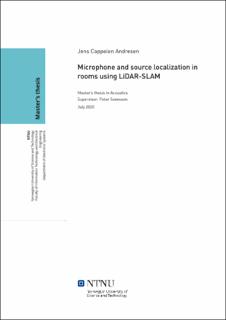| dc.contributor.advisor | Svensson, Peter | |
| dc.contributor.author | Andresen, Jens Cappelen | |
| dc.date.accessioned | 2021-09-15T17:03:42Z | |
| dc.date.available | 2021-09-15T17:03:42Z | |
| dc.date.issued | 2020 | |
| dc.identifier | no.ntnu:inspera:54579301:52359059 | |
| dc.identifier.uri | https://hdl.handle.net/11250/2778139 | |
| dc.description.abstract | Hvis et automatisk målesystem som er kapabelt til å måle tusenvis av impulsresponser i rom skal bli utviklet må en pålitelig teknikk for lokalisering av mikrofonene utvikles. Denne masteroppgaven undersøker om bruk av LiDAR-SLAM for lokalisering kan være veien å gå for et slikt målesystem. Noen av de mulige bruksområdene for et slikt system blir også undersøkt.
En versjon av dette systemet ble brukt til å måle 48 impulsresponser i forskjellige posisjoner i et rom. Identifikasjon av ulike bølgefronter kombinert med forskjellene i gangtiden ble brukt til å estimere posisjonen til kilden og førsteordens speilkilder. I dette prosjektet er mikrofonene plassert i én høyde som resulterer i lokalisering av kilden i 2D. Ved en potensiell utvidelse av systemet vil også 3D-lokalisering være mulig.
I tillegg til resultatene fra forsøkene kommer en del hvor mulige endringer til det nåværende system diskuteres, og hva som kan jobbes videre med for å gjøre drømmen om en automatisert målerobot til virkelighet. | |
| dc.description.abstract | If an automated measuring system capable of measuring thousands of impulse responses in rooms is to be created a reliable way of localizing the microphones is needed. This thesis investigates if the LiDAR-SLAM technique for localizing the measurement microphones is the way to move forward with this system. It also looks into what some of the possible applications of such a system could be.
Using a version of this system 48 impulse responses were measured in different positions in a room. By identifying different wavefronts combined with time difference of arrival the position of the source and the first-order image sources could be estimated. This project uses microphones in one height resulting in 2D localization of the source. With an expansion of the system 3D localization will be possible.
Along with the results from the measurements a section discussing what changes should be made to the current system, and what further work should be done to make the dream of an automated measurement robot into a reality. | |
| dc.language | eng | |
| dc.publisher | NTNU | |
| dc.title | Microphone and source location in rooms using LiDAR-SLAM | |
| dc.type | Master thesis | |
